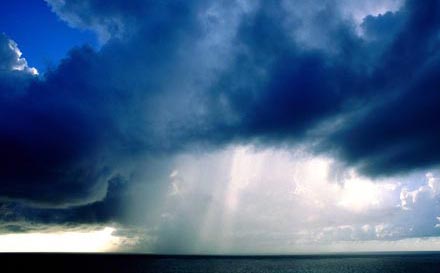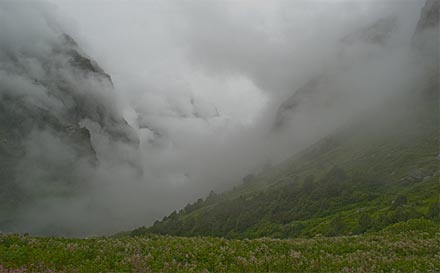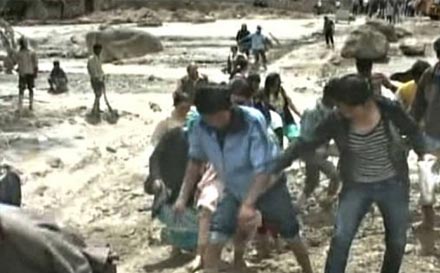What is cloud burst?
A cloudburst is sudden copious rainfall. It is a sudden aggressive rainstorm falling for a short period of time limited to a small geographical area.
Meteorologists say the rain from a cloudburst is usually of the shower type with a fall rate equal to or greater than 100 mm (4.94 inches) per hour.
Generally cloudbursts are associated with thunderstorms. The air currents rushing upwards in a rainstorm hold up a large amount of water.
If these currents suddenly cease, the entire amount of water descends on to a small area with catastrophic force all of a sudden and causes mass destruction. This is due to a rapid condensation of the clouds.
They occur most often in desert and mountainous regions, and in interior regions of continental landmasses.
During a cloudburst, more than 2 cm of rain may fall in a few minutes. They are called 'bursts' probably because it was believed earlier that clouds were solid masses full of water. So, these violent storms were attributed to their bursting.
One of the major disasters from a cloudburst in India occurred in 2002 in Uttaranchal. Some 28 people died when villages like Marwari, Kotsisham, Matgoan and Agonda were hit by sudden cloudbursts.
Cloudbursts frequently occur in Himachal Pradesh during the monsoon.
How does it happen?
Various researches suggest that they are manifestations of intense vortices on small scale that generate strong convection currents, which lift the moisture laden air with sufficient rapidity to form cumulonimbus clouds shedding water load with great strength and ferocity.
Why are the hilly areas more prone to cloud burst?
The topographical conditions like steep hills favour the formation of these clouds. And also the devastations, as water flowing down the steep slopes bring debris, boulders and uprooted trees with great velocity damaging any structure that comes in their way.
Can it be predicted?
There is no satisfactory technique for anticipating the occurrence of cloud bursts because of their small scale. A very fine net work of radars is required to be able to detect the likelihood of a cloud burst and this would be prohibitively expensive. Only the areas likely to receive heavy rainfall can be identified on a short range scale. Much of the damage can be avoided by way of identifying the areas and the meteorological situations that favour the occurrence of cloud bursts.
Cloudbursts in the India
In the Indian subcontinent, a cloudburst usually occurs when a pregnant monsoon cloud drifts northwards, from the Bay of Bengal or Arabian Sea across the plains, then onto the Himalaya and bursts, bringing rainfall as high as 75 millimeters per hour.
Few disastrous cloudburst accident are as follows:
- On September 28, 1908 - A Cloudburst resulted in a flood where the Musi River was swollen up to 38-45 m. About 15,000 people were killed and around 80,000 houses were destroyed along the banks of this river.
- In July, 1970 — Cloudburst in the upper catchment area led to a 15 metre rise in the Alaknanda river in Uttarakhand. Entire river basin, from Hanumanchatti near the pilgrimage town of Badrinath to Haridwar was affected. An entire village was swept away.
- On August 15, 1997, 115 people were killed when a cloud burst came bustling and trail of death are all that is left behind in Chirgaon in Shimla district, Himachal Pradesh.
- On August 17, 1998 — A massive landslide following heavy rain and a cloudburst at Malpa village killed 250 people including 60 Kailash Mansarovar pilgrims in Kali valley of the Kumaon division, Uttarakhand. Among the dead was Odissi dancer Protima Bedi.
- On July 16, 2003, About 40 persons were killed in flash floods caused by a cloudburst at Shilagarh in Gursa area of Kullu, Himachal Pradesh.
- On July 6, 2004, At least 17 people were killed and 28 injured when three vehicles were swept into the Alaknanda river by heavy landslides triggered by a cloudburst that left nearly 5,000 pilgrims stranded near Badrinath shrine area in Chamoli district, Uttarakhand.
- On 26 July 2005, A cloudburst caused approximately 950 millimetres (37 in) of rainfall in Mumbai. over a span of eight to ten hours; the deluge completely paralysed India's largest city and financial centre.
- On August 16, 2007, 52 people were confirmed dead when a severe cloud burst occurred in Bhavi village in Ghanvi, Himachal Pradesh.
- On August 7, 2009, 38 people were killed in a landslide resulting from a cloudburst in Nachni area near Munsiyari in Pithoragarh district of Uttarakhand.
- On August 6, 2010, in Leh, a series of cloudbursts left 179 persons dead and over 400 injured in the frontier Leh town of Ladakh region in Jammu and Kashmir.
- On September 15,[year missing] cloud burst in Almora in Uttrakhand has drowned away two villages one of them being Balta, leaving a few people alive and rest entire village dead and drowned. Almora has been declared as a town suffering from the brunt of cloudburst by authorities of Uttrakhand. Had there been a bit more swaying of clouds, town of Ranikhet must have drowned also.
- On June 9, 2011, near Jammu, a cloudbursts left 4 persons dead and over several injured in Doda-Batote highway, 135kms from Jammu.Two restaurants and many shops were washed away
|




